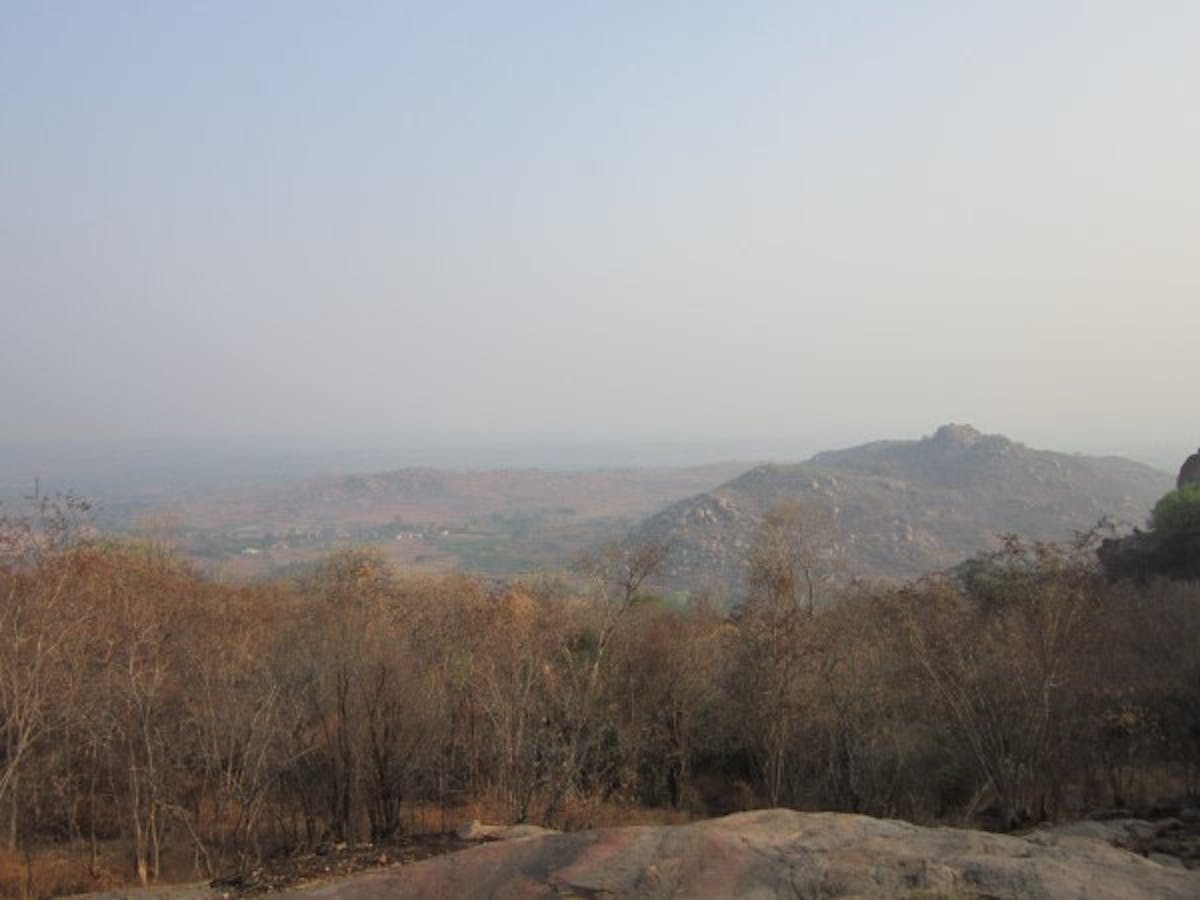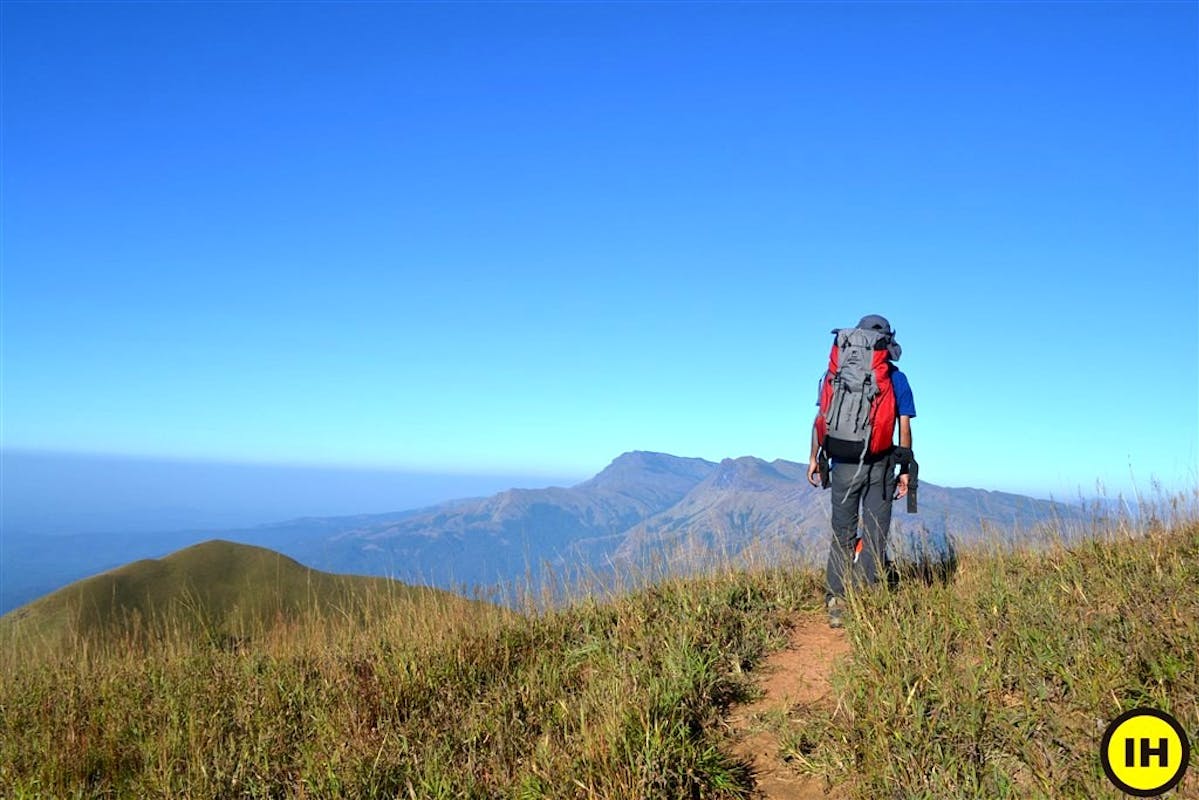Can You Help Us With Photographs Of This Trek?
We are looking to enrich this documentation with more photos. Pictures go a long way in explaining the trail, more than words ever can. If you have done this trek, can you share your photos with us? We will include them on this page, with due credit to you.Click here to contribute.
The Complete Guide to Ranganathaswamy Betta Trek
The trail starts from a Maruti temple at Koonala Doddi. From the village, walk towards the temple. Turn right at the temple to climb up the hill. The narrow path is lined with bushes and trees. After a level path of 500 m, the path becomes steeper and the forest, denser. You may find signs of wildlife - elephants, bears and other animals en route.
After around 30 minutes, spot a wide boulder. From this point, the trail becomes steeper. There are a few taxing stretches, where you may have to climb on all fours. But the trail also levels out at some places, providing you with a bit of relief.
Recently, trekking at Ranganathswamy Betta has been banned by forest officials due to the presence of wild animals such as elephants. Alternately, you can take your vehicle by the road route to the top.
➤ Short Itinerary
Calming solitude at Bilikal Betta, two hours from Bangalore
- Narrow winding trails, creaking bamboos, daring stretches, chance encounters with wild animals; a trek to Bilikal Betta is all this and more. The hill is filled with silence, which comes as a surprise as it's a mere two-hour drive away from Bangalore.
- Bilikal Betta or Ranganathaswamy Betta as it also called, at 1,552 m, is located 60 km from Bangalore on Kanakapura road. The hill derives its name from the Ranganathaswamy temple atop the hill. “Bili” in Kannada means white, and “Kallu” means stone. As the name indicates, there are interesting white rocks atop the hill. The trekking route is well-paved as it is regularly used by pilgrims visiting the temple.
➤ Trail Information
The trail starts from a Maruti temple at Koonala Doddi. From the village, walk towards the temple. Turn right at the temple to climb up the hill. The narrow path is lined with bushes and trees. After a level path of 500 m, the path becomes steeper and the forest, denser. You may find signs of wildlife - elephants, bears and other animals en route.
After around 30 minutes, spot a wide boulder. From this point, the trail becomes steeper. There are a few taxing stretches, where you may have to climb on all fours. But the trail also levels out at some places, providing you with a bit of relief.

On the way up the trail of Ranganathaswamy Betta. Picture by Aditya Patawari
It takes around 2 hours on this alternating climb to get to the top. The trail joins a jeep track that is meant for vehicles coming to the temple from the Kanakapura side. The temple of Ranganathaswamy is towards your left.
The temple is underneath a gigantic granite boulder that also acts as the roof of the temple. Opposite the temple is a small pond. The top offers a panoramic view of neighbouring hills like Savandurga and Kabbaladurga, and other hills in Kanakapura.
Descent
Take the same route to descend. You will reach the base of the hill within 45-60 minutes. Alternatively, you can also choose to get down via the jeep track. But that will take you towards Kanakapura side and to villages Sunghatta and Chakanahalli. It is longer and you may have to walk around 3 kilometres to reach the village Sunghatta. The frequency of getting buses towards Kanakapura from here is also less.
Camping
Trekkers cannot camp anymore at the hilltop. It is not allowed by the forest officials.
Many years ago, there was an option. A moonlight trek to this place was also possible. But beware of wild animals. It is also essential to take food along with you as the last shop selling snacks is at Dodda Maralawadi. The best time to visit this place is just after the monsoon, preferably from August to January, when the whole place is abundant with greenery.
➤ How to Reach the Base of Ranganathaswamy Betta Trek
There are two ways to reach the hill. One route is via Bangalore-Kanakapura Road. If you are driving, take a left at the village of Harohalli. This turn takes you to Dodda Maralawadi village and then to the village of Koonala Doddi, from where the trek begins.
If you are driving from Bangalore-Mysore Road, then take a left at Channapatna. This turn takes you towards Kanakapura.
There are also plenty of buses plying towards Kanakapura from Bangalore. Get down at Harohalli and then take a local bus towards Dodda Maralawadi. From here, you can take another local bus or catch an auto to Koonala Doddi.
➤ What to Take on Your Trek

No, stuffing it all in isn’t the right way to do it Packing a backpack correctly saves precious time that you might waste trying to find your things later. It is wise to spend some time on learning what really goes into packing a backpack.
What should I pack?
On a trek, you only get what you take. Something as simple as a forgotten matchbox can cripple your cooking plans throughout the trek. So, it’s essential to prepare early and prepare well. To begin with, make a checklist. While shopping, remember this thumb rule - keep it light. “Every item needs to be light. This ensures that your backpack, on the whole, stays light,” says Sandhya UC, co-founder of Indiahikes. Balancing out heavy items with light ones isn’t going to have the same effect as having all light items. “Always opt for good quality, light items,” says Sandhya.
How much should my bag weigh?
“Your backpack for a weekend trek should weigh between 8 and 10 kg,” explains Arjun Majumdar, co-founder of Indiahikes, “To break it down, your tent should weigh around 2.5 kg, your sleeping bag, around 1.5 kg, and the ration, stove and clothes should constitute the other 5 kg.” The best way to plan is by concentrating on the basic necessities – food, shelter and clothes. Gather only those things that you’ll need to survive. Do not pack for ‘if’ situations. “That’s one of the common mistakes that people make – packing for ‘if situations’. It only adds to the baggage that you can do without on a trek,” says Sandhya.
One good way to go about it is to prepare a list of absolute essentials. Start with the most essential and end with the least essential. That way, when you feel you are overshooting the limit, you can start eliminating from the bottom. Another tip is to be smart while packing clothes. Invest in light. wash and wear fabrics. "Replace a sweater with two t-shirts," adds Sandhya. Layering is the mantra when it comes to trekking. Refer to Sandhya’s clothes list to pack smart.
How to pack
The thumb rule for this one is to eliminate air spaces. Make sure that everything is packed tightly, especially clothes and jackets, as they tend to take up maximum air space. Put in all the large items first. Then squeeze in the smaller ones in the gaps. This ensures minimum air space. A good way to pack clothes is by using the Ranger Roll method.
Where to pack
Bottom - Sleeping bag: Make this your base layer. Sleeping bags tend to be voluminous, but do not weigh much. They’re perfect for the bottom of the bag. Tent: Just like the sleeping bag, even tents are voluminous and light. Keep the tent poles separately and place the fabric at the bottom of the backpack.
Middle - Heavy jacket: Roll up the jacket in a tight ball and place it in the middle of the backpack, close to your back. The middle region of the backpack should always have the heaviest items. You can store other things like ration or mini stoves in the middle. Other clothes: Roll other clothes and place them in the remaining space, to fill air gaps.
Top - Water: Water, although heavy, needs to be easily accessible. So put it in the topmost region of your backpack. Medicine box: This is another component that you wouldn’t want to be scavenging for when in need. Poncho: It could rain at any time in the mountains. So, ponchos should be accessible easily. Also, having a waterproof poncho at the top of the backpack provides additional waterproofing to items in the bag.
➤ How To Prepare For Your Trek
Cardiovascular Endurance
The secret to ascending any trail lies in building your cardiovascular endurance. You can begin by jogging every day. Ideally, you should be able to jog 4 km in 20 minutes before the start of the trek. It takes time to be able to cover this distance in the given time. Start slow and increase your pace every day. Swimming, cycling and stair climbing without too many breaks in between can help too. Strength This is another area you should work on. You will need to build strength in your muscles and in your core body. You can do some squats to strengthen your leg muscles. Do around 3 sets of squats, with 8 squats in each set. Apart from this, you can add planks and crunches to your workout.
Flexibility
Another aspect that will help you trek comfortably is flexibility. For this, you can do some stretching exercises - stretch your hamstrings, quadriceps, hip flexors, lower back muscles and shoulders regularly. Carrying a backpack, no matter how light, can become a strain after a while. These exercises will help you to be in good shape before the trek. Working out indoors
If you can't go out and jog because of time and space constraints, here's a video you can use to work out indoors.
➤ Trek Contribution
Trek Explored and Documented by: Aditya Patawari
Trek Written by: Usha Hariprasad